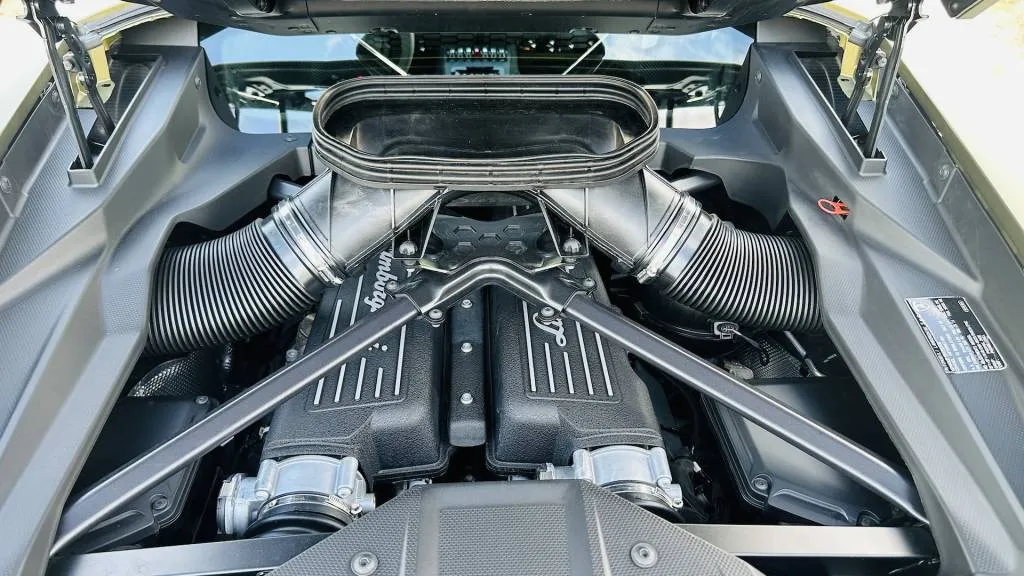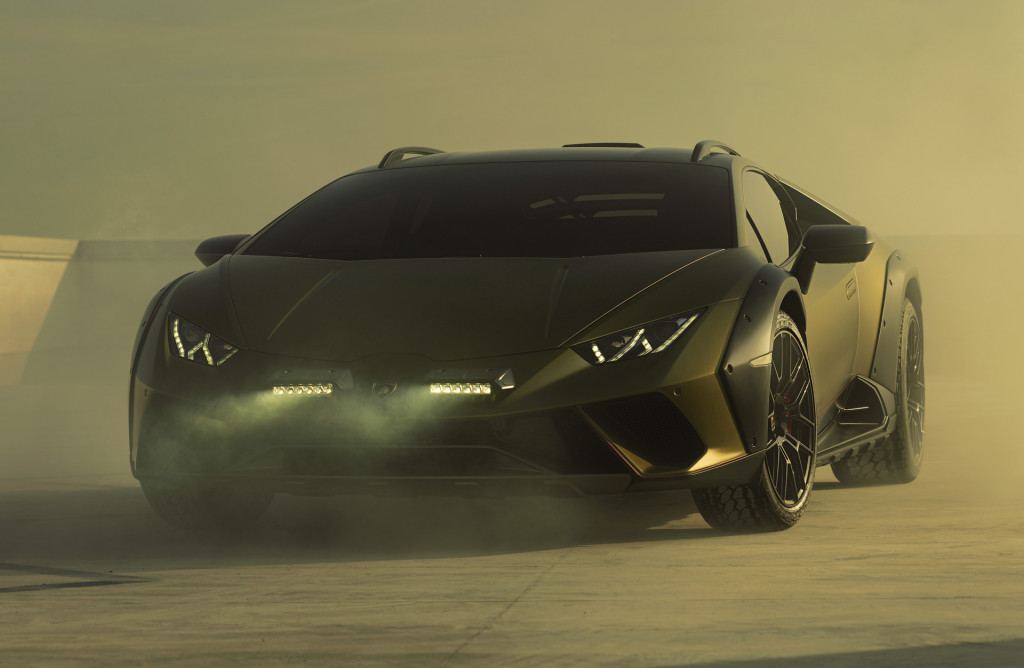-
The Sterrato is the best Huracán model for daily driving
-
Bridgestone A/T tires still provide decent grip on the pavement
-
6.4 inches of ground clearance is lot for a Lambo, but not for off-roading
I’ve been driving in the dirt pretty much all my life. My childhood weekends were spent in the desert hooning three-wheelers, and later my dad’s Volkswagen dune buggy, at iconic California desert locations like Glamis, Johnson Valley, and Ocotillo Wells. As an adult, I graduated to racing air-cooled VWs in events like the Baja 1000 and rallying stock vehicles in navigational challenges including the Rebelle Rally. Most recently I’ve built, raced, and podiumed a lifted Miata.
I know how to drive a car in the dirt and stay within its limits. So, when Lamborghini told me I could have the Huracán Sterrato but had to keep it to the tarmac, I was more than a little annoyed.
While I can’t tell you how Lambo’s lifted supercar actually behaves when the road gets a bit rougher, I’ll use this review to tell you how it drives around town and how I think it would behave off-road. I’ll also dive into the technical aspects as much as I can.
2024 Lamborghini Sterrato, Emme Hall photo
Huracán Sterrato: Mannerly on-road
The Sterrato came out last year as an off-road-focused send-off for the Huracán, and all 1,499 units are spoken for. While I can’t off-road it, I am able to use it as a daily driver in my little desert town. Hooo boy, do I get attention! I’ve never been a fan of the Huracan’s design aesthetic—to me it looks like a geometric pancake—but the matte green color, black wheel cladding, and roof rack appeal to my more-rugged nature. I can’t stop at a red light or hit a Chipotle without garnering looks from every other person. Some are fans who eagerly approach me to ask about the car. Others give me the stink-eye from a distance then drive by with a “Go Back to L.A.” sticker clearly visible on their back window. I mean, I’m a local but whatevs, amigo.
For a week I go about my daily errands, and find that the seats aren’t rock hard nor are they so snug that my lady hips feel constricted.
The Sterrato rides nearly two inches higher than a standard Huracán, sitting 6.4 inches off the ground. The height makes it easier to get in and out. My 81-year old mom had no problems when I took her for a spin. I still scrape the front a time or two on some particularly steep driveways, but most of the time it is a non-issue.
There is about four cubic feet of space in the front trunk, enough for a bag of groceries or two, and had I wanted to I could have tied down some larger items on the roof rack.

2024 Lamborghini Sterrato, Emme Hall photo

2024 Lamborghini Sterrato, Emme Hall photo

2024 Lamborghini Sterrato, Emme Hall photo
However, rearward visibility is terrible. If any vehicle needs a rear camera mirror it’s the Sterrato. The standard rearview mirror just shows me the louvers over the engine bay. They sure do look cool from the outside, but be prepared to use your side mirrors to make up the difference.
My favorite interior feature is the steering wheel. It’s sized perfectly for my hands, covered in suede for more grip, and the flat bottom leaves room for my knees. I thought I was going to hate the turn signal switch on the steering wheel, but I feel it allows me to keep a better grip on the wheel as I was signaling. I want this in my car!
The infotainment system, however, is not great. The system is pretty laggy and Apple CarPlay seems buggy, dropping out more than once. I went through all the menus and never found an efficiency calculator so I’m not sure what exactly my mileage was during my time with the car. The EPA gives the Sterrato a combined fuel rating of 15 mpg, and I have no reason to doubt that number. The Sterrato does have the ability to display my latitude and longitude as well as my current heading. As a map nerd, this is very much appreciated.
Around-town driving is pretty easy in Strada mode, which keeps the 5.2-liter V-10 in check. The 7-speed dual-clutch automatic transmission shifts quickly and isn’t harsh. In this mode, it’s easy to just cruise around town, stress-free. However, the roof rack creates plenty of wind noise, especially at highway speeds. Between that, the road noise from the Bridgestone Dueler A/T tires and the stonkin’ V-10, I can barely hear my podcast while toddling down the freeway.

2024 Lamborghini Sterrato, Emme Hall photo
But this is a Lamborghini, and I want the feel of all 602 ponies and 413 lb-ft of torque. I have plenty of flat, straight, paved (unfortunately) roads nearby. I do a recon run to make sure the road is in good condition, turn around and switch to Sport mode. I launch it, pedal to the metal and…it’s kind of meh. It takes a beat for the power to kick in off the line. However, after a thunk into second gear, the Sterrato comes into its own and my heart starts racing—well, a little bit. Maybe I’ve been in too many pure electric vehicles lately with their instant torque, but this car’s 0-62 mph time of 3.4 seconds feels almost slow now. A Lucid would spank this thing off the line.
Not to worry. The Huracán’s successor, the Temerario, will be electrified with a Lamborghini-claimed 0-62 mph time of 2.7 seconds and more than 900 hp. Yowza.
Still, I take the Sterrato up to triple-digit speeds and the car feels confident and planted with no squirrelly reactions at the rear wheels when I hit the brakes. In the twisties, I can feel less grip from the A/T tires on the pavement than I’d expect in any other Huracán, but the Sterrato still holds a mountain road at 70-80 mph without a problem.

Lamborghini Huracán Sterrato

Lamborghini Huracán Sterrato

Lamborghini Huracán Sterrato
Huracán Sterrato: The off-road bits
The Huracán Sterrato is well behaved on-road, but it’s built with a bunch of off-road parts. The Bridgestone all-terrain tires are sized 235/40/R19 in the front and 285/40/R19 in the rear, and the tread appears to be a good compromise for on- and off-road driving. A smaller wheel would allow more sidewall, but the Sterrato has some honking-big brakes. A 19-inch wheel is as small as you can go.
You do not get a spare tire with the Sterrato, which is not good because tire failure is the number one problem folks encounter when they venture off the pavement. The Bridgestones are run-flats so in theory you can drive 50 miles at 50 mph with puncture in the sidewall or tread. Those who have spent any time off-road, however, know that a gash in the sidewall is more common than a puncture. My recommendation is to strap a full-size spare to your roof rack. That’s what it’s there for.
Don’t go thinking you’re going to conquer the Rubicon Trail in this thing. It might be lifted to 6.4 inches of ground clearance, but that’s less than the typical crossover SUV. The geometry is still terrible with approach, breakover, and departure angles of 10.4, 14.7, 26.5 degrees, respectively. To be fair, that departure angle is actually pretty good, besting the Ford Ranger Raptor by 0.1 degree. Still, you’ll scrape pretty much everything else trying to climb over all but the smallest obstacles, and while there is some protection under the car, it’s not what I would call beefy.
I take the car to my local oil change place so I can get a good look underneath it. Lamborghini adds metal protection on the front and mid sections of the car, but it’s only about ⅛-inch thick. Hard plastic is used in some places and what covers the engine is the most flimsy of all. Nothing covers the exhaust system.
As far as the suspension goes, it’s not like the Sterrato’s magnetic dampers have long travel, nor do the control arms look any longer. Lamborghini wouldn’t confirm it, but I can’t imagine that the Sterrato has any more wheel travel than the road-going Huracán. Between the geometry and the travel, this car is meant for flat rally roads with a bit of a washboard surface. I wouldn’t put it through the whoops at speed.

Lamborghini Huracán Sterrato
However, I would take it to the dunes. Just air down the tires and let the all-wheel drive system and automatic rear locker do their things. The sand won’t damage anything underneath the car, and as long as you lift just before you crest the dune, you won’t launch it. You might still have some problems with the nose scraping coming off of steep dunes, but taking it at an angle should help. My plan for this car was to hoon it around the soft sand at Pismo Beach and capture some epic photos but, alas, Lamborghini lawyers denied me—and you—the pleasure.
As I mentioned, all units are spoken for, so you don’t have to worry about scraping together the nearly $280,000 it costs to drive one off the showroom floor. That price includes a $2,100 gas guzzler tax and a destination charge of $3,695. Nor does it include $16,500 for the awesome matte green paint, $7,600 for the sport seats, $6,000 for the forged wheels, or $2,600 for the extra LED rally lights on the front that legit look like they came from AutoZone. All told, my tester comes out to $360,349, which is seven times what my graduate-level education cost.
Still, I can’t deny that the Sterrato is by far the easiest Lamborghini Huracán you could drive on the daily. The increased ride height means you can toddle around town with no fear of speed bumps, and the Strada mode keeps the power levels manageable when speed limits are low. It’s probably really fun on a smooth dirt road, too. But then again, how would I know?
Read the full article here

